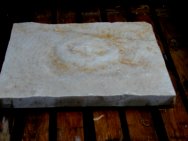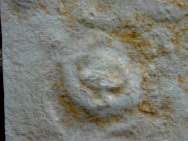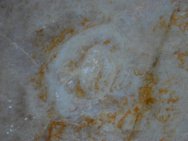Madusa Scyphozoa Jellyfish Ichnofossil
Phylum Cnidaria, Class Scyphozoa; with similarity to extant Order Scyphomedusae
Geological Time: Upper Cambrian (about 510 million years ago)
Size: Matrix measures 24 by 26 inches, and up to 2.5 inches thick; actual weight is 95 pounds
Fossil Site: Blackberry Hill, Krukowski Quarry, Elk Mound Group, near Mosinee, Wisconsin
Code: DD701
Price: $1800.00
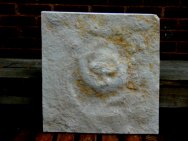 Phylum
Cnidaria (anemones, corals, jellyfish and sea pens) are among the most ancient
animals, simplest in body form, and yet are ubiquitous and widespread even
today in marine environments. The earliest forms in the fossil record appear
in Ediacarian fauna of Southern Australia, which dates to the Precambrian
some 600 million years ago. This is clear testiment that old and simple
animals can be enormously successful.
Phylum
Cnidaria (anemones, corals, jellyfish and sea pens) are among the most ancient
animals, simplest in body form, and yet are ubiquitous and widespread even
today in marine environments. The earliest forms in the fossil record appear
in Ediacarian fauna of Southern Australia, which dates to the Precambrian
some 600 million years ago. This is clear testiment that old and simple
animals can be enormously successful.
Here we have
a sandstone plate with a large Madusa Cambrian Ichnofossil from the Mount
Simon Wonewoc Sandstone in Central Wisconsin. Being comprised entirely
of soft tissue unlike animals with exoskeletons (e.g., trilobites) or
skeletons  (vertebrates),
jellyfish fossils are body fossils that are impressions of the jellyfish.
Such fossil impressions are rare, especially from the Cambrian. Jellyfish
were some of the most ferocious predators of
(vertebrates),
jellyfish fossils are body fossils that are impressions of the jellyfish.
Such fossil impressions are rare, especially from the Cambrian. Jellyfish
were some of the most ferocious predators of 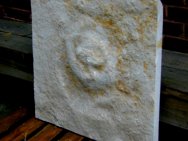 the
Cambrian marine environment. These fossils from the Wisconsin quarry are
not just large for the Cambrian, but are the largest jellyfish
in the entire fossil record. The epirelief
preservation found in these jellyfish fossils was likely due to sediment
that was trapped within the gastric cavity and/or attached to oral arms
and lappets a the animal struggled after standing on a Cambrian shoreline.
This particular specimen is one of the few largest and most detailed
to be extracted from the quarry, and truly deserving of the accolade,
Museum Grade. The specimen is entirely natural. The block was cracked
during cutout, and repaired but this does not detract from front-facing
appearance.
the
Cambrian marine environment. These fossils from the Wisconsin quarry are
not just large for the Cambrian, but are the largest jellyfish
in the entire fossil record. The epirelief
preservation found in these jellyfish fossils was likely due to sediment
that was trapped within the gastric cavity and/or attached to oral arms
and lappets a the animal struggled after standing on a Cambrian shoreline.
This particular specimen is one of the few largest and most detailed
to be extracted from the quarry, and truly deserving of the accolade,
Museum Grade. The specimen is entirely natural. The block was cracked
during cutout, and repaired but this does not detract from front-facing
appearance.
These jellyfish come from a particular horizon in the Mount Simon Sandstone that also yields facinating Diplichnites, Protichnites, and Climactichnites.
Also see: Cambrian Shadows Madusae Jellyfish Fossils
Hagadorn, J.W., Dott, R.H., and Damrow, D., 2002, Stranded on an Upper Cambrian shoreline: Medusae from Central Wisconsin: Geology, v. 30, p. 147-150.
